Henri Cartier-Bresson once described photography in the following way: “For me, the camera is a sketchbook, an instrument of intuition and spontaneity the master of the instant which, in visual terms, questions and decides simultaneously.”1 True to his words, Cartier-Bresson came out as a unique photographer who used his camera to capture simple moments, which edified human expressions, expectations, and struggles. He viewed photography as capturing a decisive moment – an occurrence that takes place at a fraction of a second yet encapsulates the core of the entire event happening. This was his ultimate advantage in becoming one of the best photographers of his time, and the reason why was that he allowed the viewers to see things exactly how they were by avoiding cropping or manipulating his images.
Although Cartier-Bresson was born in Europe, his works transcended the continent. For the many years he was into photography, he traversed the world to capture great moments in Asia, Africa, and even America.2 Unlike many photographers before him, Henri Cartier-Bresson believed in capturing spontaneous moments rather than carefully engineering an image on his own for a predetermined effect. To him, having people pose for photographs was akin to stage managing photography. In fact, he was heavily influenced by realism and the surrealist movement, which was rife at the turn of the 20th century.3 His dedication to capturing the images true to life demonstrates the realistic influence, and clear focus and precision are reminiscent of surrealist paintings. Ultimately, Cartier-Bresson’s influence on street photography was capturing a moment in motion while maintaining a geometrically organized composition and minding the surroundings, and many photographers, such as Robert Capa and David Seymour followed his suit.
The following discourse will focus on the influence of the photographer on street photography in Europe. First of all, it will highlight some of his works and give an overview of the photographer’s work, location, and technique. More importantly, the discussion will focus on the thematic issues which come out from the works of Cartier-Bresson. After that, the discussion will shift to the influence of Cartier-Bresson in Europe and beyond, and comparisons will be made to the works of other photographers who shared the same techniques and employed similar approaches.
As mentioned above, Cartier-Bresson aimed for capturing a decisive moment as it was in real life, with no staging and no interference on the photographers part whatsoever. One of his most notable photographs is Behind the Gare Saint Lazare, and it is quite characteristic in this respect.4 Cartier-Bresson’s predisposition toward street photography without poses is evident in the photo. The image captures a man running over a large puddle of water behind a railway station in the high point of his jump. It is a direct opposite of a carefully staged shot since it would be impossible to make a person pose in midair. Thus, Cartier-Bresson does not merely avoid posing but denies its very idea, which is a clear testament to his views on the importance of suddenness and spontaneity.
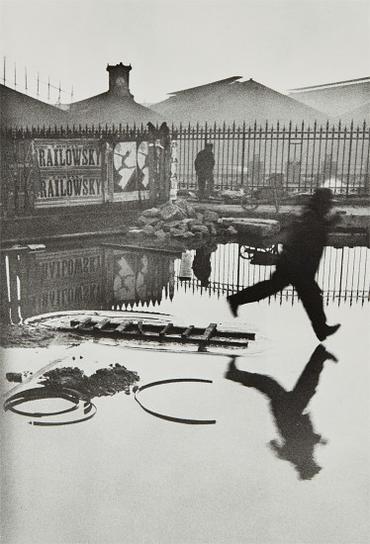
Another essential aspect of Behind the Gare Saint Lazare is its composition since it illustrates the author’s approach to setting and getting a perfect shot while maintaining his characteristic adherence to suddenness. While Cartier-Bresson insisted on capturing a fleeting moment, the quest for spontaneity did not excuse negligence toward proper composition as far as he was concerned. On the contrary, he claimed that internal geometry and balance were as essential for street photography as the true-to-life nature of the moments it depicted.5 The composition of Behind the Gare Saint Lazare is a testament to this principle. A large poster on the left balances the running man on the right, while the person standing immediately behind the fence separates the piece into two vertical halves and organizes the shot symmetrically. Lining up a shot like that was likely a complex task requiring swiftness and precision, which was why Cartier-Bresson stressed the necessity of being patient in waiting and quick in execution.6 The time spent waiting for the perfect shot and the swiftness of clicking the shutter in rapid succession both paid off when a photograph saw the light.
One more important feature of Cartier-Bresson’s approach to street photography was his insistence on depicting the people in unity with the environment. The photographer stressed that a great picture comes not only from trained instincts or the ability to recognize a perfect composition but also from the attention to one’s surroundings.7 His Men Laying on Grass from the cycle America in Passing offers a clear example of such attention because it is the surrounding environment that brings the people together. The image, as the title suggests, depicts several men sitting of laying on grassy terrain. They obviously come from different backgrounds: a gentleman in the foreground is wearing a suit and shining shoes while those in the back have simpler clothes. The poses vary as well: the man in the front sits pensively with his fingers interlocked, the one in the background sprawls lazily, and the one in the middle ground just sleeps. The only factor that unites them is the surrounding environment – a grassy patch of ground that they have chosen to ruminate, rest, or sleep and, by doing so, created a strange momentary community depicted in the photo.
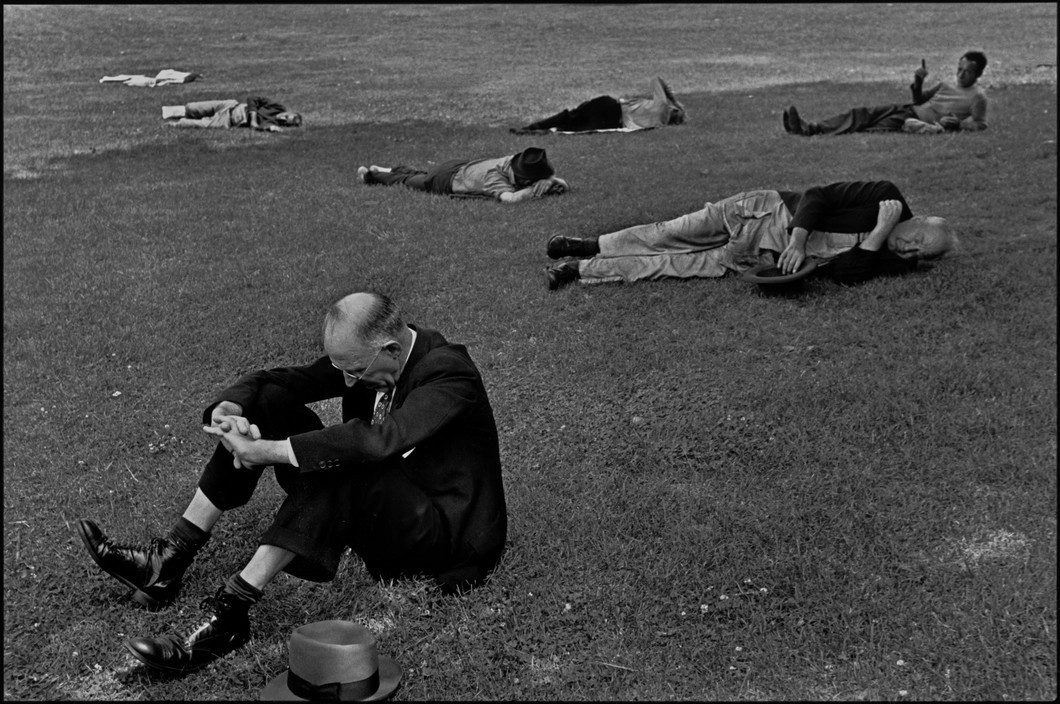
Finally, apart from spontaneity, composition, balance, and careful attention to surroundings, Cartier-Bresson’s style also relied on concealment to a sufficient degree. The essence of street photography is to capture great moments with little interference, and this is precisely what Cartier-Bresson espoused in his works. As far as he was concerned, photography has to be mundane and as natural as possible. This approach required being as discreet and hard to notice as possible: he often took photographs without his camera flashing since he never wanted to appear intrusive. In most of his works, he used a Leica camera that was small enough to be concealed and, as a consequence, allowed him to remain hidden until he clicked the shutter. This propensity to remain unnoticed allowed some students of Cartier-Bresson’s work to liken him to a “stealthy street peddler without a license, capturing with his lens what he found”.8 In other words, Cartier-Bresson thrived on simplicity and aimed to depict life as it is. These principles continue to define street photography up to this day, showcasing the French photographer’s importance to the genre.
Cartier-Bresson’s works and his general approach to street photography were a notable influence on many other artists in Europe and beyond. Moreover, he worked closely with other renowned photographers of the mid-century, such as Robert Capa and David Seymour. Their works often demonstrate the shared ideas about street photography that remain influential up to date and adhere to the same principles first outlined by none other than Cartier-Bresson himself.
Clearly influenced by his cooperation with the great French photographer, Robert Capa often exhibited the same techniques and themes that Cartier-Bresson was partial to. One of the most evident examples would be Running for Shelter during the Air-Raid Alarm. In this photograph taken in Barcelona during the Spanish Civil War, Capa focused on a woman hurriedly running for shelter during an air raid alarm. The picture shares the element of spontaneity with the majority of Cartier-Bresson’s photographs.9 It is quite reminiscent of Behind the Gare Saint Lazare, since both photos depict a person in the middle of running and likely utterly oblivious to the photographer, thus denying the very idea of posing. Moreover, Running for Shelter corresponds to Cartier-Bresson’s notion of making “images à la sauvette,” which means “images on the run” in the most literal sense.10 The propensity toward catching an unwitting person in a fleeting moment of time without anything remotely resembling posing and premeditated staging is perfectly evident in this piece and may serve as a proof of Cartier-Bresson’s influence on Capa.
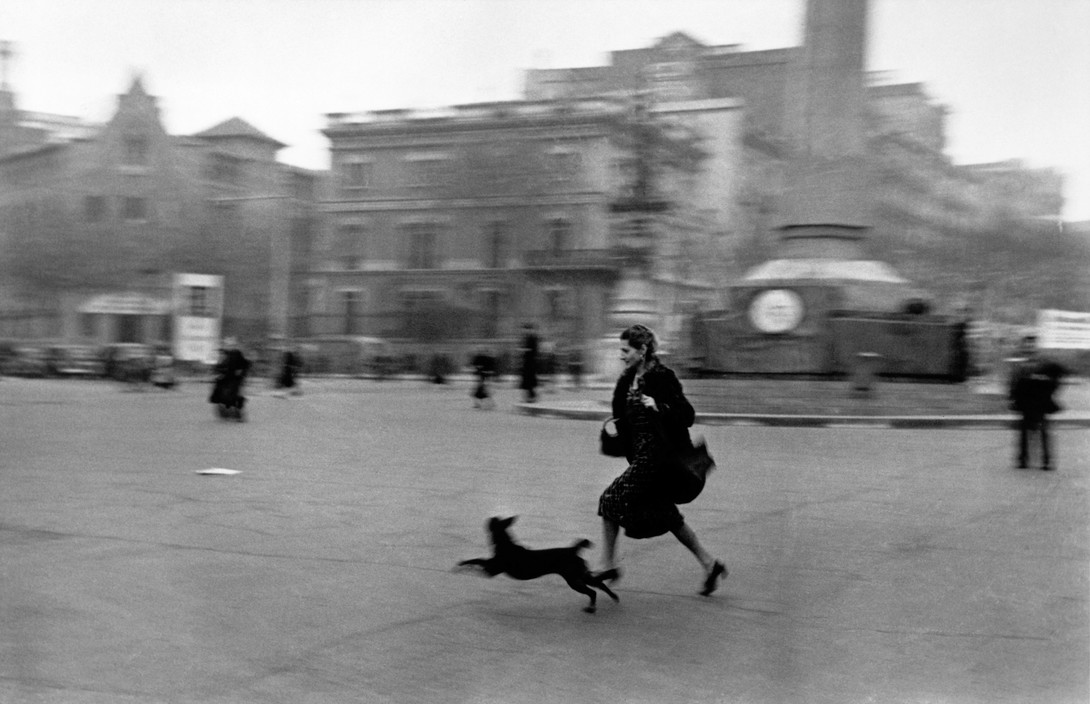
Another factor that stands out in the photograph is the thematic focus on people within their surrounding environment. While the centerpiece of the photo is the running woman and the dog that accompanies her, with the background being blurry and out of focus, the latter is by no means unimportant. It is within the context of the surrounding environment that the photograph assumes its full meaning. The woman is not merely running because she is late to an appointment – she runs to take cover from the bombs in the city threatened by the civil war. The dog’s joyful prancing also assumes additional meaning in context, as it contrasts the grim reality of the incoming air raid. As such, Running for Shelter may serve as a textbook example of assessing the importance of the event happening despite its spontaneous nature.11 Cartier-Bresson considered such recognition, inextricably bound to the surrounding environment, to be the essence of photography, and it seems that Capa shared this sentiment, thus making it one more notable influence.
David Seymour’s pivotal works also demonstrate ideas similar to those of Cartier-Bresson, especially when it comes to capturing a single moment in motion. It is understandable, as the two worked closely together in the 1930s.12 This tendency is clear his photographs from the series titled National Strike for the 40-Hour Week, Paid Holidays, and Collective Agreements. One picture in particular depicts a large group of French workers entertaining each other during a sit in their factory, and its attention to capturing a fleeting moment and seizing motion on film would likely make Cartier-Bresson proud. The image portrays the dancing workers in the middle of their movement, with hands spread and legs raised. It is the same “cessation of the subject in motion” that Cartier-Bresson demonstrated in his Behind the Gare Saint Lazare.13 More than that, the photo also does not have anything resembling intentional posing: since the workers interlock their hands and move constantly, none of them could pause and pose even if they tried. As one can see, Seymour also demonstrates the same adherence to capturing the decisive moment as it is rather than carefully craft a piece with preselected poses.
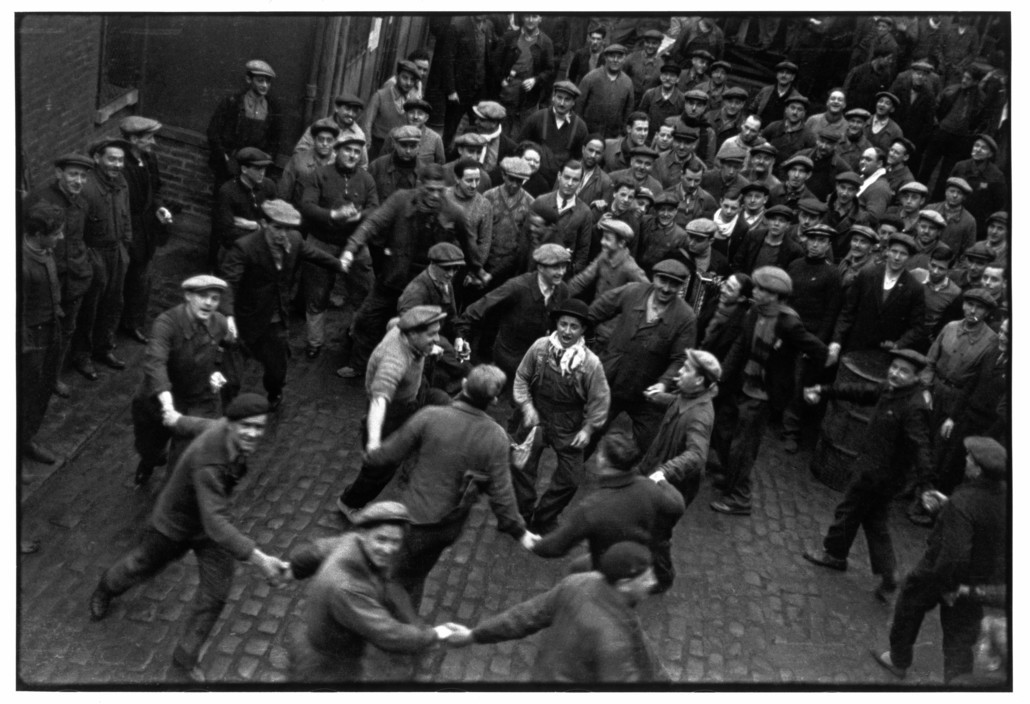
Another notable stylistic choice that demonstrates a clear influence of Cartier-Bresson’s work is the composition and spatial organization of the shot. Geometrically speaking, National Strike includes three concentric circles: a lone man performing in the center, a small ring of seven workers dancing around them, and a much larger ring dancing around the other two. As mentioned above, finding a “geometrically balanced scene” in the midst of the inherently chaotic street landscapes was a landmark of Cartier-Bresson’s style, and Seymour clearly follows the steps of his French colleague. Moreover, the fluid body language of the dancers, their interlocked hands, and the circles they make produce what is likely an intentional similarity to Henri Matisse’s Dance depicting a similar, if smaller, group of dancers. Considering this, the composition of the photograph goes beyond adding a geometrical quality to the event and imbues it with additional artistic associations. This thorough and careful attention to composing and balancing a shot was a trademark of Cartier-Bresson’s work – and, as demonstrated by Seymour’s National Strike, an influence on many other photographers as well.
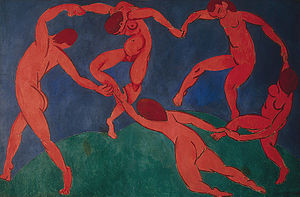
In conclusion, Henri Cartier-Bresson’s photography has a significant influence both in the USA and Europe. The trademark of the French photographer’s style was capturing a fleeting moment, often in motion, while staying true to life and disregarding posing. Cartier-Bresson also paid careful attention to the composition and geometrical balance of the shot as well as the importance of the surrounding environment. Finally, capturing the events true-to-life without being intrusive and engineering the shot by hand required concealment. These features manifest in such works as Behind the Gare Saint Lazare and Men Laying on Grass. They have remained important principles of street photography as a genre up to this day and impacted many other artists in the years to come. In particular, Robert Capa’s Running for Shelter and David Seymour’s National Strike demonstrate Cartier-Bresson’s influence in the way they approach movement, composition, and the depiction of the surrounding environment.
Bibliography
Backman, Marjorie. “Henri Cartier-Bresson: The Decisive Moment. Elliott Erwitt: Pittsburgh 1950.” Afterimage 45, no. 4 (2018): 31-34.
Bair, Nadya. “The Decisive Network: Producing Henri Cartier-Bresson at Mid-Century.” History of Photography 20, no. 2 (2016): 146-166.
Cartier-Bresson, Henri. The Mind’s Eye: Writings on Photography and Photographers. San Francisco: Aperture, 2005.
Cartier-Bresson, Henri. “Henri Cartier-Bresson: The Eye of the Century.” Queens Quarterly 121, no. 2 (2014): 166-179.
Cookman, Claude. “Compelled to Witness: The Social Realism of Henri Cartier-Bresson.” Journalism History 24, no. 1 (1998): 2-15.
Cookman, Claude. “Henri Cartier-Bresson Reinterprets his Career.” History of Photography 32, no. 1 (2008): 59-73.
Palmer, Daniel. “Lights, Camera, Algorithm: Digital Photography’s Algorithmic Conditions.” In Digital Light, edited by Sean Cubitt, Daniel Palmer, and Nathaniel Tkacz, 144-162. London: Open Humanities Press, 2015.
Footnotes
1. Henri Cartier-Bresson, The Mind’s Eye: Writings on Photography and Photographers (San Francisco: Aperture, 2005), 15.
2. Claude Cookman, “Henri Cartier-Bresson Reinterprets his Career,” History of Photography 32, no. 1 (2008): 59-73.
3. Claude Cookman, “Compelled to Witness: The Social Realism of Henri Cartier-Bresson,” Journalism History 24, no. 1 (1998): 2-15.
4. Henri Cartier-Bresson, “Henri Cartier-Bresson: The Eye of the Century,” Queens Quarterly 121, no. 2 (2014): 166-179.
5. Nadya Bair, “The Decisive Network: Producing Henri Cartier-Bresson at Mid-Century,” History of Photography 20, no. 2 (2016): 148.
6. Bair, “The Decisive Network,” 148.
7. Bair, “The Decisive Network,” 148.
8. Marjorie Backman, “Henri Cartier-Bresson: The Decisive Moment. Elliott Erwitt: Pittsburgh 1950.” Afterimage 45, no. 4 (2018): 31.
9. Daniel Palmer, “Lights, Camera, Algorithm: Digital Photography’s Algorithmic Conditions,” in Digital Light, ed. Sean Cubitt, Daniel Palmer, and Nathaniel Tkacz (London: Open Humanities Press, 2015), 144.
10. Backman, “Henri Cartier-Bresson,” 31.
11. Palmer, “Lights, Camera, Algorithm,” 144.
12. Cookman, “Compelled to Witness,” 8.
13. Bair, “The Decisive Network,” 148.